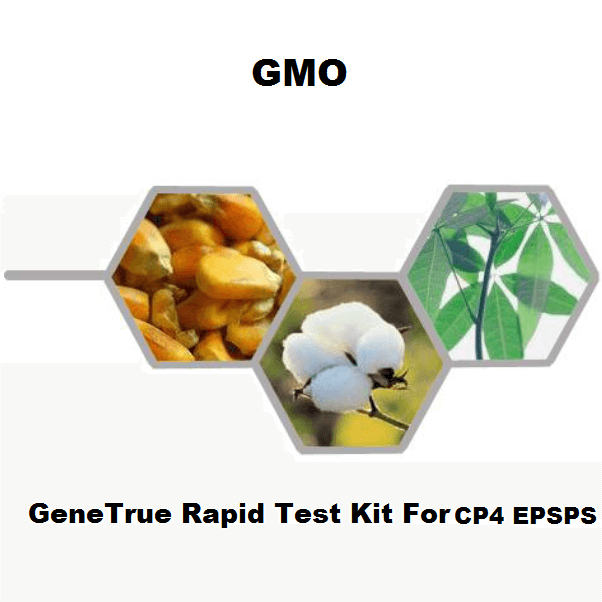PROPERTIES
PRODUCT DESCRIPTION
INTENDED USE
The GeneTrue CP4 EPSPS Rapid test Kit is intended to determine the presence of the CP4 EPSPS protein in genetically modified organisms.
EPSPS or 5-enolpyruvyl-shikimate synthase is an enzyme that catalyzes a reaction in plant and bacterial cells that is necessary for the synthesis of some amino acids. The herbicide, Roundup (glyphosate), can bind to the EPSPS enzyme made in plants and block its ability to work. This causes the plant to run out of amino acids which halts growth and development. The plant eventually dies from starvation. Roundup is a non-selective systemic herbicide which means it injures and often kills most plants that come into contact with it. CP4 EPSPS is the protein introduced by genetic manipulation that is expressed in glyphosate-tolerant soybeans, which are being developed to provide new weed-control options for farmers. Expression of this protein in plants imparts high levels of glyphosate tolerance. The safety of CP4 EPSPS was ascertained by evaluating both physical and functional characteristics. CP4 EPSPS degrades readily in simulated gastric and intestinal fluids, suggesting that this protein will be degraded in the mammalian digestive tract upon ingestion as a component of food or feed
Limit of detection: 1 ng/ml or 1 in 1000 Kernels
STORAGE
The test device in seal pouch should be stored at 2-30ºC. Do not freeze the test device The test device should be kept away from direct sunlight, moisture and heat
CONTENTS
Pouch (contains: test strip and desiccant). Test instructions.
MATERIALS REQUIRED (NOT PROVIDED)
-Tube -Pestle (for leaf samples only)
-Seed crusher (for seed samples only)
-Tap water
TECHNICAL SPECIFICATIONS
SAMPLE PREPARATION
Preparation of the sample is a crucial step for the test to run effectively. To prepare the sample, first grind the plant seeds/ leaves/ seedlings/ other materials that need testing.For plant components that are not listed below, please refer to the table and draw inferences by selecting the closest component category that would be most applicable for the sample. After completing the process of grinding the sample and adding water, ensure that the sample is mixed properly. This can be done by shaking or centrifuging the test tube. Once this has been accomplished, allow the mixture to stand for a while. It is recommended that you remove the liquid (supernatant) fraction of the ground plant mixture to another container for testing.
For single seed types:
Ground a single seed sample (0.5-2 g ground seeds) in a container and add water or buffer. Mix for 15–25 seconds and let the sample settle before testing.
For a mixture of different seed types:
Grind 200 g of mixed seeds. In a beaker, combine 20-50 g of the ground sample with water or buffer. Mix for 2-5 minutes and let the sample settle before testing.
For leaf tissue from the single plant type:
Take a 1-inch x 1-inch leaf punches from the sample leaf tissue (0.15-0.3 g); push the leaf punches into the tube using a pestle. Add 3 mL of water or buffer into tube and grind the tissue using the pestle. This will result in a dilution of 1:20, if 0.15 g or 1:10, if 0.3 g. Let the paste settle for at least 45 seconds before testing or further dilution with water or buffer.
For leaf tissue from a mixture of different plant types:
Take a 1-inch x 1-inch leaf punches from each of the different sample leaf tissue (total 0.2-0.4 g); push the leaf punches into the tube using a pestle. Add 4mL of water or buffer into tube and grind the tissue using the pestle. This will result in a dilution of 1:20, if 0.2 g or 1:10, if 0.4 g. Let the paste settle for at least 45 seconds before testing or further dilution with water or buffer.
HOW TO RUN THE STRIP TEST
*Remove the testing device from the foil pouch by tearing at the notch. Hold the strip at the colored end. Do not touch the arrow end or the test window (the middle part of the strip).
* Holding the strip vertically, immerse the end of the strip with the arrows into the sample liquid. Do not immerse past the MAX line.
* Take the strip out when the sample has migrated to the test window (about 10 seconds). Lay the strip (MAX side facing up) flat on a clean, dry, non-absorbent surface.
* Wait 2-5 minutes for the result. If there is only one line appears, allow the strip to develop for an extra 10 minutes before completion of the test. Results visible after 30 minutes are considered invalid.
INTERPRETING THE RESULTS
* A positive result is the presence of two purple bands: one on the test (T) line and one on the control (C) line.
* A negative result is the presence of one purple band on the control (C) line.
* An invalid result: no band is present on the control (C) line. This may suggest the procedure was done incorrectly or the test strip was faulty. Re-test with another strip.



